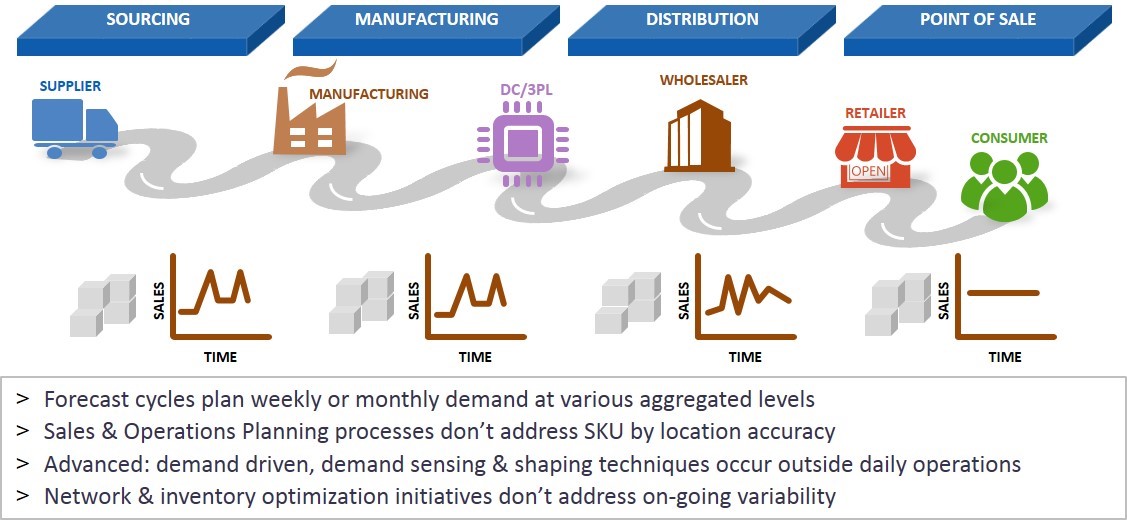Have you considered there may be a better way to structure supply chain? I have sure have and it doesn’t look much like the linear Supply Chains of today. Why not? Because the Supply Chains of today suffer from delays, poor forecast accuracy and the silo mentality. The good news? Advances in technology like Machine Learning and AI can fix all this.
Traditionally, we view the Supply Chain as a chain of sequential links each with behavioral attributes which act both separately and together to cause demand variation from historical performance. The “linked” supply chain is characterized by linear time delays in communicating of variance to the forecast, and amplification in volume as demand is placed back from many demand points to fewer supply points. What is this known as? That’s right, the Bullwhip Effect.
As demand variations are communicated sequentially through the Supply Chain, the time delays and signal variations that cause error propagate throughout the network as per the following illustration:

Do linear Supply Chains really work? They are responsible for the negative bullwhip effect.
Statistical forecasts are based on historical data, and are not representative of causal factors associated with new product introductions
The Core Problems Of Linear Supply Chain
Planners are making daily multi-million dollar working capital decisions based on little more than spreadsheets and tribal knowledge.
Statistical forecasts are based on historical data, and are not representative of the existing and future conditions (causal factors) associated with new product introductions that influence demand. The departments responsible for creating, marketing, and selling (Demand Creation functions), do everything they can to change history. As a result, the forecast for sourcing, making, and delivering (Demand Fulfilment functions) is always wrong.
The time delays associated with S&OP processes exacerbates forecast error
S&OP Makes Bullwhip Effect Worse
Sales & Operations Planning (S&OP) is a noble attempt to capture causal factors. However, the time delays associated with S&OP processes exacerbates the error. The statistical forecast is only useful when determining a basis for segmentation, analyzing patterns, and creating baseline forecasts. As a result, statistical forecasts about Stock Keeping Units (SKUs) at the location level, for example, will always be inaccurate on a day to day basis.
The resulting culture accepts the inaccuracy, moves on, and no one identifies, collects or explains the reasons why the forecast was wrong and to consider those recurring causes in the future. To improve forecast accuracy, organizations need to collect and study the causal factors that are likely to increase or decrease demand, across the business, to determine and manage variability from baseline demand, for each item, at each location.
In the past, we theoretically knew the impact that promotions and controllable factors would have on the forecast, especially in consumer goods where syndicated data and analytics are readily available. However, from an operations perspective, obtaining the marketing and promotional plans was cumbersome and arduous.
To improve forecast accuracy, organizations need to collect and study the causal factors that are likely to increase or decrease demand
Improved Forecast Accuracy Is Here – But We Need A New Supply Chain Model
With digitalization, the Internet of Things, Cognitive Analytics and Machine Learning, consideration of external and internal causal factors are a new opportunity to dramatically improve forecast accuracy based on new insights. Cloud deployed connectivity, computing power, data share, communication, and digital technology are breaking the barriers of siloed functions. You can’t break down the silos but, you can connect them in near real time from the points of final demand to the points of original supply. With “digital connected commerce”, omnichannel demand management enables daily forecasting and recasting. Time delay is replaced by near zero information latency and amplification synchronized and nullified taming the Bullwhip Effect.
To get started though requires a new business model, based on new mental models, advanced analytics maturity, and a new culture that demands planning excellence that avoids or overcomes the first pitfall of Supply Chain planning. New organizational models and structures to leverage new and more abundant sources of demand and supply data are emerging. In the coming weeks, we’ll explore more of the common pitfalls to Supply Chain planning.
[Ed: For further debate on this topic, IBF thought leader Eric Wilson argues that S&OP isn’t working, exploring the efficacy of the traditional approach to managing Supply Chain.]

